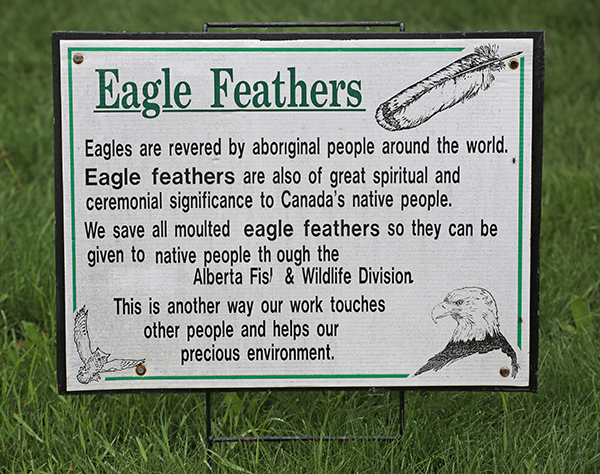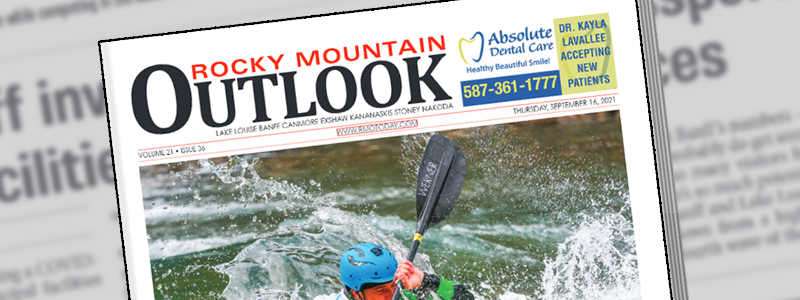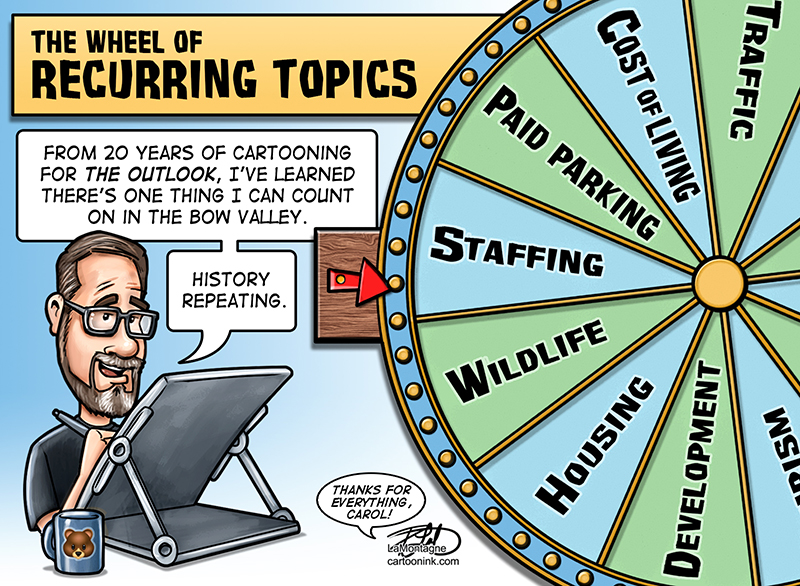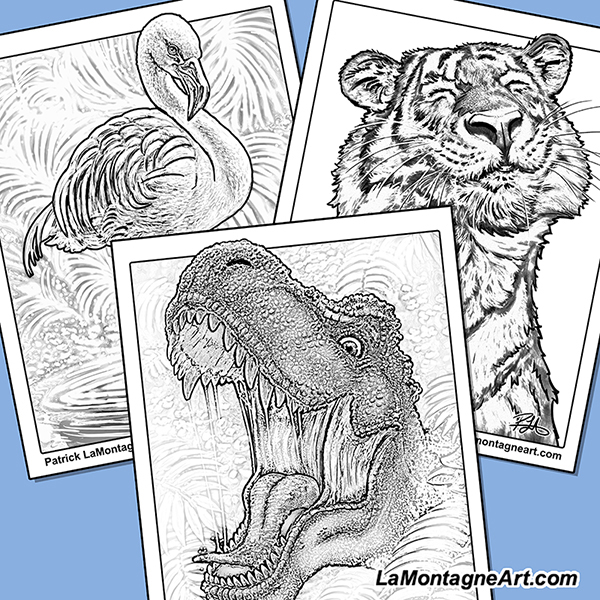
It would be an understatement to describe this past year as challenging. However you choose to define it, we’ve all lost something, and much of it won’t be coming back.
Those newspapers that laid me off a year ago said that it would be temporary, but to still believe that now would be wishful thinking. We can choose to desperately hang on to false hope or have a moment of grief and move on.
Like many people, I’ve been struggling with next steps and feeling a little bit helpless and defeated, despite knowing I’ve got plenty for which to be grateful.
There’s an old Zen proverb that states, “when the student is ready, the teacher appears.”
I’ve been fortunate in my career to have a couple of mentors, people without whose assistance I might not be a self-employed artist today.
In 2001, at thirty years old, I was drawing a weekly editorial cartoon for the Banff Crag and Canyon, something I’d done for a few years. At the time, I had no designs on becoming a professional artist; it was just an amusing side gig. Even still, I began drawing other cartoons for casual clients along with some illustration work. When my newspaper publisher discovered this, she told me I could only draw cartoons for The Crag in Banff and couldn’t do any other cartoons. For $30 a week, I was not about to accept that and planned to quit.
At the same time, an upstart newspaper was about to launch in Canmore. The owners wanted to create a better vision of a paper for the whole Bow Valley, consisting of Exshaw, Canmore, Banff and Lake Louise. One of the Crag and Canyon reporters left to join the new paper and let them know I was unhappy. The new editor had already planned to offer me the job as their editorial cartoonist.
It was only a bit more money, but Shonna and I had just left Banff to buy our first home in Canmore, and the timing was right.
Carol Picard was the editor and part-owner, and before too long, she asked me why I wasn’t syndicated. I told her it was difficult for an unknown artist to sign with a syndicate.
She told me that was silly, that I should do it myself, something I didn’t know was possible. At the time, submissions went by fax (look it up, kids). So I went to the library in Calgary to find all of the addresses and contact info for Canadian newspapers. None of that information was as yet available online.
And I bought a fax machine.
 For the next couple of years, in addition to the Rocky Mountain Outlook cartoon, I drew two or three cartoons a week, sent them out to newspapers and got almost no bites. It was brutal, demoralizing and I came close to quitting many times. I had a full-time job to pay the bills and drew cartoons early in the mornings before work and in the evenings afterward, as well as every weekend.
For the next couple of years, in addition to the Rocky Mountain Outlook cartoon, I drew two or three cartoons a week, sent them out to newspapers and got almost no bites. It was brutal, demoralizing and I came close to quitting many times. I had a full-time job to pay the bills and drew cartoons early in the mornings before work and in the evenings afterward, as well as every weekend.
It took over a year of submissions, but I still remember my first syndicated weekly paper, The Vulcan Advocate. They paid me $10 a week for a syndicated cartoon. That first $40 cheque was like winning the lottery. By the end of the second year, I had two papers.
Carol no longer owns the Rocky Mountain Outlook, but it survives and thrives today. Their competitors, the same two papers that ridiculed them for their brash audacity; one is gone and the other is a shell of what it once was.
I still draw a local cartoon for The Outlook. It will be twenty years this fall since their first issue, and I have never missed a week. There is no doubt in my mind that I wouldn’t be an artist for a living had Carol not intervened at the right time.
—
During those early first few years of syndicated cartooning, I watched a Sunday morning news show where they interviewed one of Canada’s most notable and accomplished editorial cartoonists, Terry Mosher. Drawing under his nom-de-cartoon, Aislin, he’s been a cartoonist since the late 60s, part of the foundation of the Montreal Gazette.
In the interview, he remarked about how difficult it was for young cartoonists to get started. In my early thirties, I was not so young, but knowing little about the rest of the industry, with no contacts to speak of, I threw a Hail Mary pass and sent him an email, asking for advice.
He replied with one line, “Send me some of your stuff.”
Over the next few years, we got to know each other, and he introduced me to the world of Canadian editorial cartooning. He told me I needed to draw more, that I had to send out at least five cartoons a week, rather than two or three.
As I wasn’t a very good artist, with no grasp of the fundamentals, it took many hours to draw a cartoon, three or four times what it takes today, so I struggled to increase my workload.
Terry was the editorial cartoon editor of Maclean’s Magazine and put me in the rotation in the company of some of the most well-known cartoonists in Canada. It paid $400, which at the time seemed like a lot of money. He introduced me to Doug Firby, the former editor of the Calgary Herald. Doug was generous with his time and advice and started using my cartoons when their in-house cartoonist Vance Rodewalt had days off.
Terry came out west in 2003 with his wife to talk at the Banff Centre and visit family in Jasper. They took Shonna and I out to dinner, and we were their guests at his presentation. It was an exciting visit. I had the assignment for Maclean’s that week. Though I don’t recall the cartoon’s context, I had to draw former Alberta Premier Ralph Klein, and I remember sending Terry the cartoon for his OK while he was still in Jasper.
He called me and said, “it doesn’t look like him.”
Having spent hours on it, I was crushed, but he told me over the phone how to fix it. Put his eyes closer together; his hair is bigger; you’ve got the mouth wrong. I scrambled to write it all down and worked ’til 2 in the morning fixing it, even though I had to be at my day job by 8:30. His critique was accurate, and he said my revision was much better.
Terry taught me how to take constructive criticism. There is ALWAYS room for improvement.
I was so appalled that I had failed to capture Klein’s face that I became obsessed with becoming an expert at capturing likenesses, which has served me well in my painted work. When Klein retired from office in 2006, I painted a caricature that appeared in the Calgary Herald and other Alberta papers. I sold a few prints of it and somebody gave him one for his retirement. This photo appeared in the Calgary Herald.
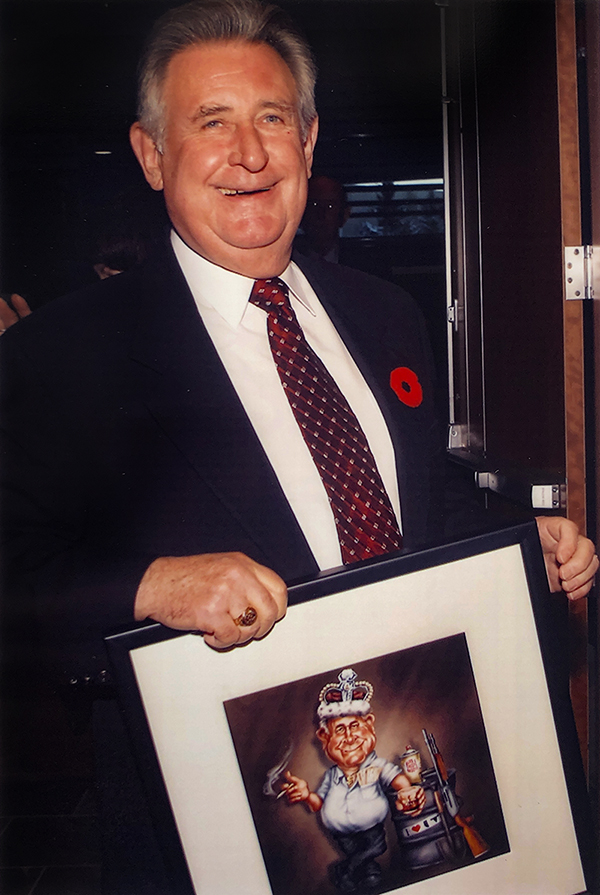 My credibility as a Maclean’s magazine cartoonist opened doors with many other newspapers across Canada. In 2005, I quit my day job and became a full-time professional artist.
My credibility as a Maclean’s magazine cartoonist opened doors with many other newspapers across Canada. In 2005, I quit my day job and became a full-time professional artist.
Because Canmore is one of Canada’s most expensive communities in which to live, there was no chance of living on one income. Shonna and I agreed that if I couldn’t pay half of the mortgage and bills, I’d get a part-time job. It didn’t seem like as big risk then as it would now.
Both Carol Picard and Terry Mosher were the mentors I needed at the time, and I remain forever grateful for their help.
—
Some time ago, my friend Crystal, a graphic designer in Calgary, recommended a podcast by David Duchemin. I’ve written about it before.
David has had a strange but wonderful creative career. He’s been a comedian, photographer, author and educator. I guarantee there are other professions in there with which I’m not yet familiar. His podcast is geared toward creatives, and it’s quite inspirational. We’re about the same age, but I think of David as older than I am, based on his wealth of experience.
I’ve never shied away from sending emails to people whenever they’ve influenced me or provided content worth my time. I know what it’s like to work in a lonely profession. No matter how successful or influential you might imagine someone might be, they’re still just people. We all like to know that we’re doing a good job or are providing value to somebody else.
People are too often quick to criticize but slow to applaud.
When I’ve found one of his podcasts particularly resonant or uplifting, I’ve sent David an email.
Not too long ago, following one of those messages, for which he was always gracious and kind, we got into a more detailed discussion about this business of art. He lives on Vancouver Island, one of Shonna’s and my favourite haunts, and he’d already said to let him know when I was next in the area.
But not too long into this discussion, he said that we should have a phone call.
After some initial small talk, David suggested I could be doing better at marketing my work. Realizing he was treating me with kid gloves, I assured him he could speak frankly. He wasn’t criticizing my art but my business, and I already knew I had plenty of room for improvement. As I said, I welcome constructive criticism, especially from somebody who has walked their talk.
He hit me with both barrels, and I couldn’t take notes fast enough.
For two hours, David lobbed marketing advice and ideas at me, and we had a fascinating discussion. Many of these suggestions seemed so obvious in hindsight, but I had never considered them. Grateful for the help, I asked him why he was so generous with his time and advice, especially since we didn’t yet know each other well.
I can’t remember his exact words, but it came down to this – for the quality of my artwork, I should be a lot further ahead, and he wanted to help me get there.
David gave me a crash course lesson in getting more newsletter followers and better serving them. He stressed the importance of focusing less on individual sales and more on my relationships with those who’ve supported my work for years. His philosophy on serving my audience revealed how I’m already doing that well and pointed out where I could be doing better.
He helped me make improvements to my website, with more changes coming. He suggested I offer desktop and mobile device wallpapers to my audience, something I should have thought of years ago, but it had never occurred to me. The immediate positive feedback from my subscribers was overwhelming. They loved them!
He reminded me that many of my customers buy my work for the children in their lives. Wouldn’t they love to be able to give their grandkids, nieces and nephews colouring pages of my paintings? What about publishing a colouring book from them later? Let me tell you, that was a palm to the forehead moment. I’m releasing a few of those to my subscribers today, and I learned a lot while creating them.
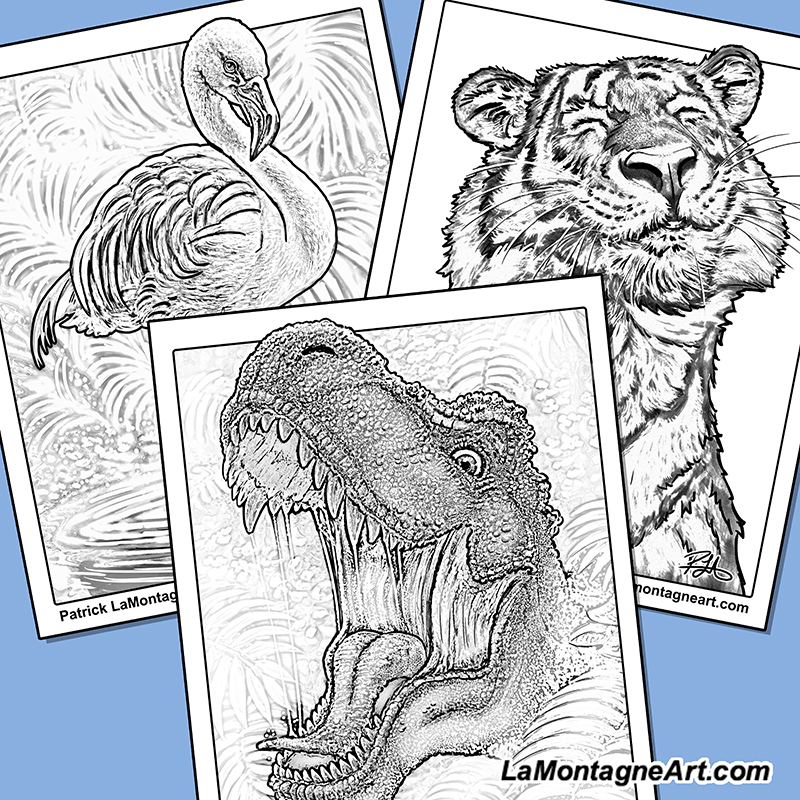 David was surprised with how quickly I’ve implemented some of the ideas generated from our discussions. My view on that is simple. When somebody gives you a push in the right direction, the one you’ve REALLY needed, you don’t sit down and think about it. You take advantage of the momentum and speed up.
David was surprised with how quickly I’ve implemented some of the ideas generated from our discussions. My view on that is simple. When somebody gives you a push in the right direction, the one you’ve REALLY needed, you don’t sit down and think about it. You take advantage of the momentum and speed up.
That’s how you show your gratitude for their generosity.
I wrote to David the other day, “While telling my wife about our last chat and the options you suggested, she said it was nice to see me excited about my work again, focusing on forward movement, rather than worrying so much.”
He replied, “That makes me very happy.”
I don’t know how long I’ll benefit from David’s willingness to share his hard-earned knowledge with me. I’m simply going to do the work to be worthy of it.
If you’re a photographer, designer, illustrator, cartoonist, any other type of creative, I’d encourage you to check out his site and listen to his podcast, ‘A Beautiful Anarchy.‘ Recommend it to any creatives in your life, too, especially if they could use a boost.
My first two mentors showed up when I was at a significant crossroads in my career and life, though I only recognized it in hindsight.
This time, there is no doubt.
Cheers,
Patrick
 © Patrick LaMontagne
© Patrick LaMontagne
Follow me on Instagram @LaMontagneArt

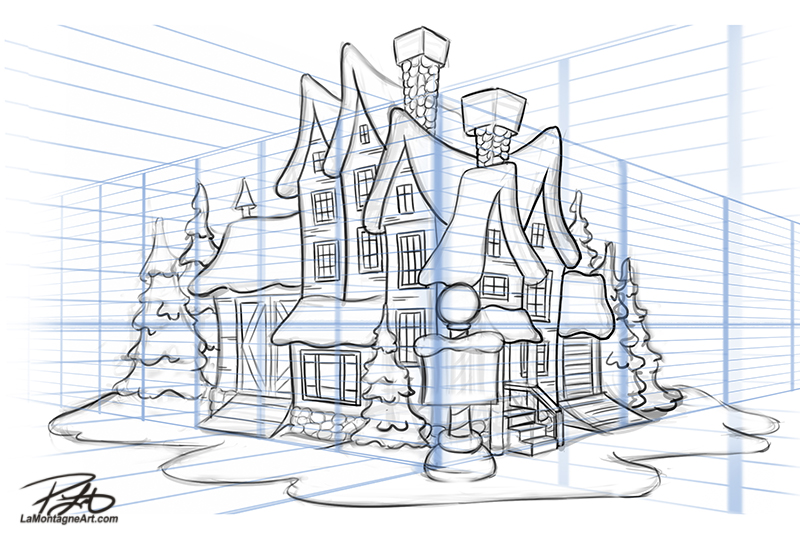
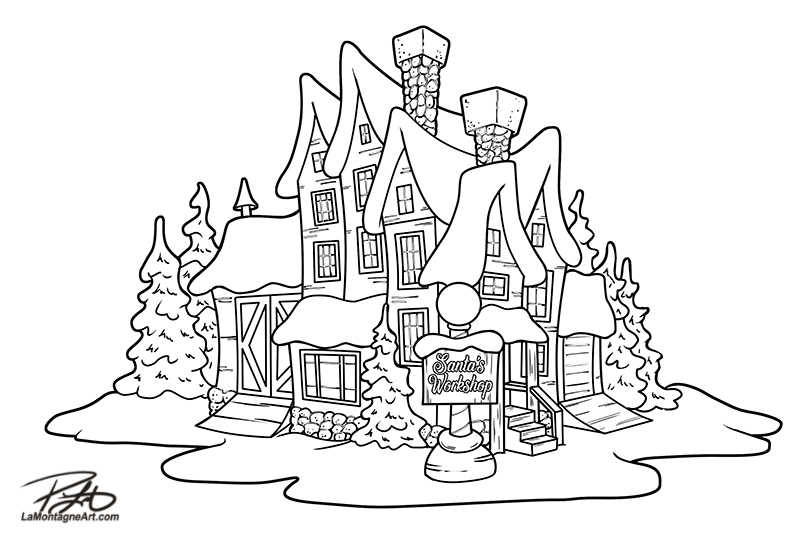 Then I’ll drop the opacity of the sketch layer, so it’s very faint and create cleaner black lines on the layer above. I call this an Ink layer, even though there’s no ink involved.
Then I’ll drop the opacity of the sketch layer, so it’s very faint and create cleaner black lines on the layer above. I call this an Ink layer, even though there’s no ink involved.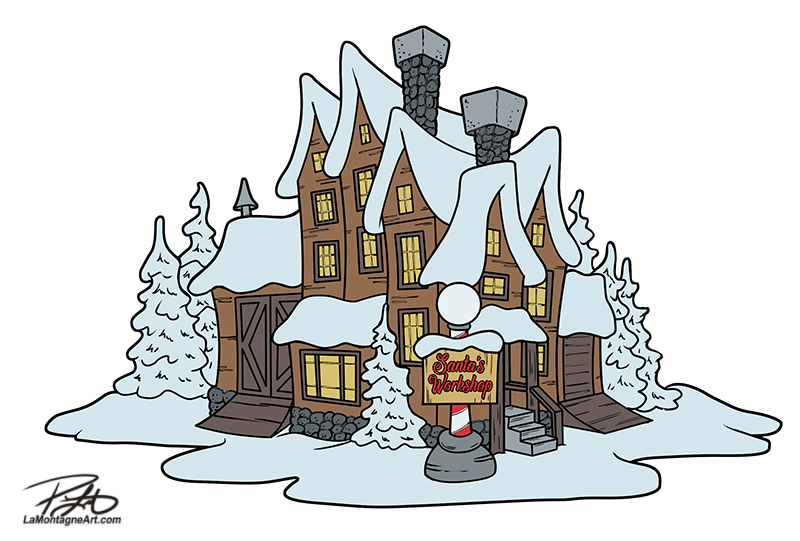 I’ll delete the sketch, create a new layer beneath the ink layer and fill in sections of flat colour on different layers. This helps me establish a base colour for separate pieces and select certain painting sections easily.
I’ll delete the sketch, create a new layer beneath the ink layer and fill in sections of flat colour on different layers. This helps me establish a base colour for separate pieces and select certain painting sections easily.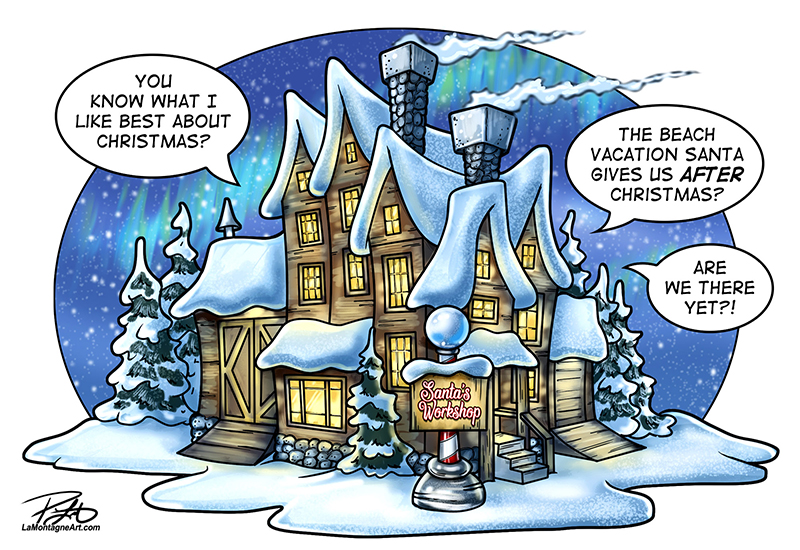 Finally, I’ll create a painted background, add talk bubbles, my text and signature, and save different formats to send to my newspaper clients across Canada.
Finally, I’ll create a painted background, add talk bubbles, my text and signature, and save different formats to send to my newspaper clients across Canada.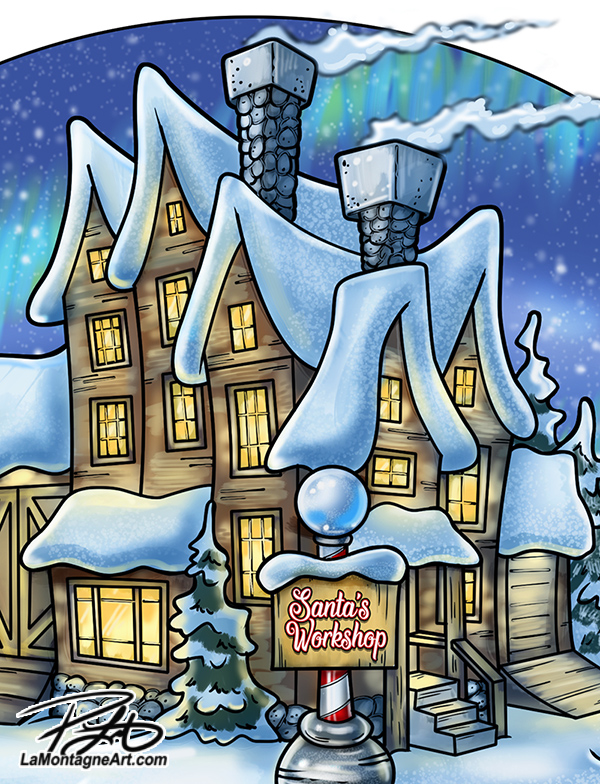 The painting process I use for my whimsical wildlife and portraits of people is more complicated because each painting takes many hours to complete and involves a lot of fine detail. But the tools are the same. Many artists have asked me about my painting brushes over the years, and they’re surprised that they’re not complicated. Just like in traditional art, it isn’t the brush; it’s the person wielding it.
The painting process I use for my whimsical wildlife and portraits of people is more complicated because each painting takes many hours to complete and involves a lot of fine detail. But the tools are the same. Many artists have asked me about my painting brushes over the years, and they’re surprised that they’re not complicated. Just like in traditional art, it isn’t the brush; it’s the person wielding it.


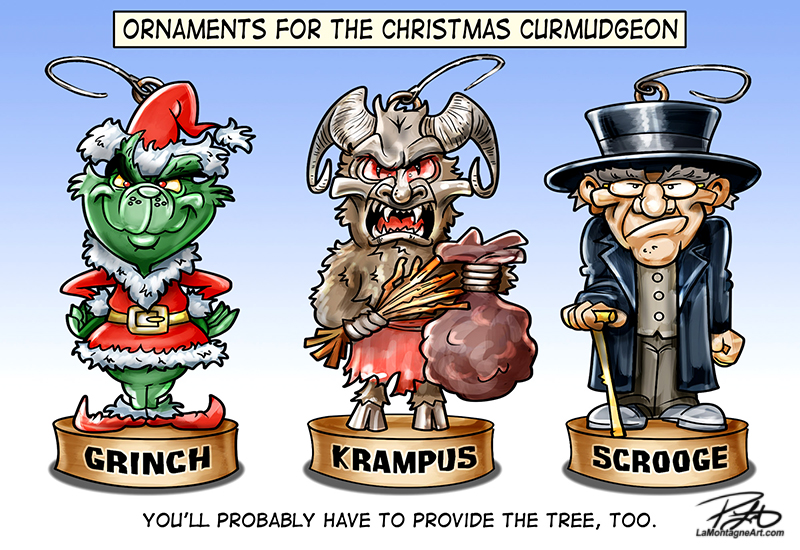 Near as I can tell, it was the seven years working in the tourism industry in Banff that exorcised the spirit of Christmas from this here cartoonist and painter of whimsical wildlife.
Near as I can tell, it was the seven years working in the tourism industry in Banff that exorcised the spirit of Christmas from this here cartoonist and painter of whimsical wildlife.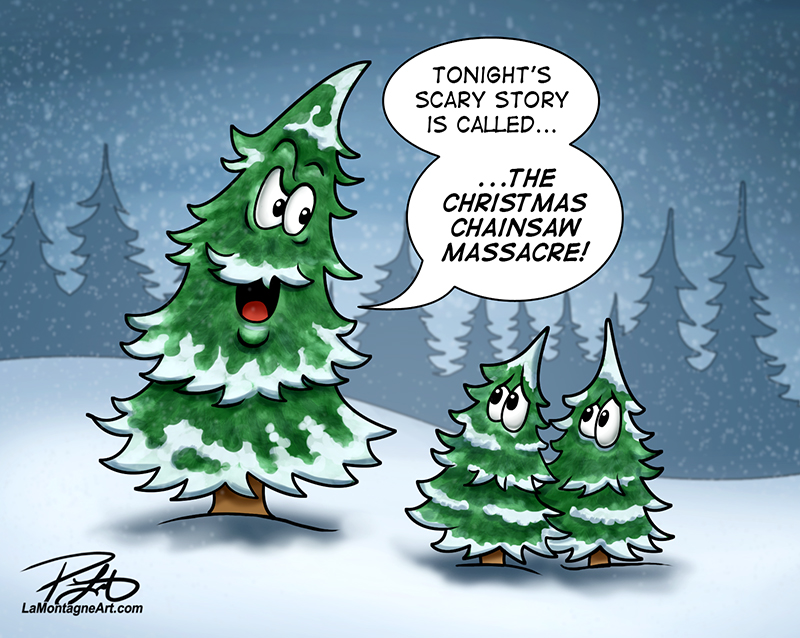 Shonna and I have not had a tree or decorations in more than twenty years. Aside from a few extra blankets on the couch, our home looks the same on December 25th as on July 25th. We don’t exchange gifts, and we don’t make a big meal.
Shonna and I have not had a tree or decorations in more than twenty years. Aside from a few extra blankets on the couch, our home looks the same on December 25th as on July 25th. We don’t exchange gifts, and we don’t make a big meal.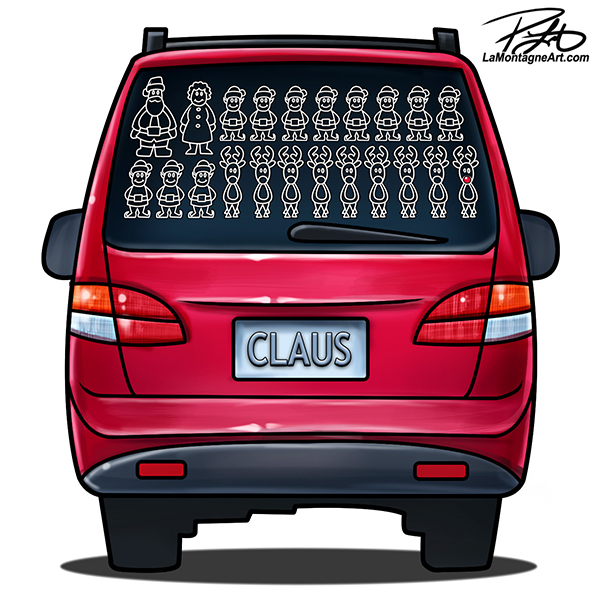 I welcomed the excuse not to travel. In the darkest month, with the best chance for the worst weather and most treacherous driving, while we’re all under peak stress, everybody hits the road at the same time. And if the highways close for a winter whiteout, and the RCMP tell you to stay home, well, that’s just too bad. Find a way; otherwise, you’ve ruined Christmas for everybody.
I welcomed the excuse not to travel. In the darkest month, with the best chance for the worst weather and most treacherous driving, while we’re all under peak stress, everybody hits the road at the same time. And if the highways close for a winter whiteout, and the RCMP tell you to stay home, well, that’s just too bad. Find a way; otherwise, you’ve ruined Christmas for everybody.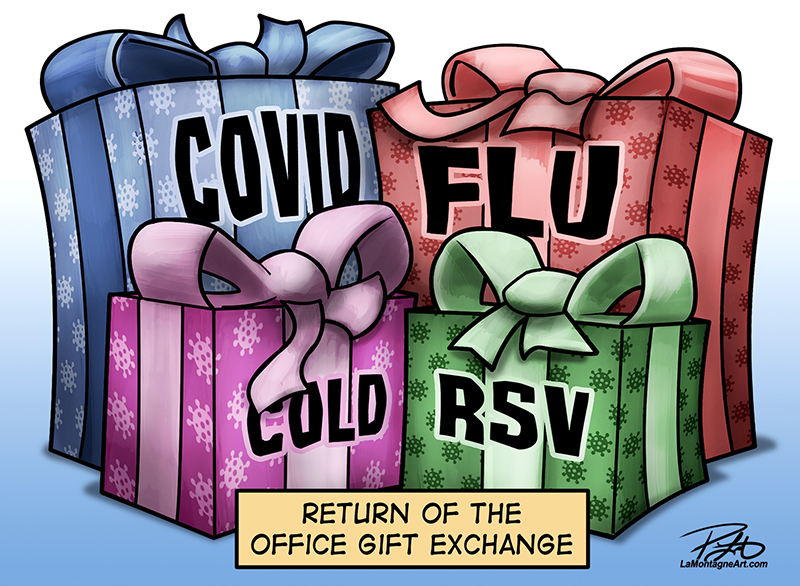 Even before the pandemic, ‘tis the season when we’re all contagious. So, we get together with as many people as possible, cram ourselves into crowded spaces, shake hands, hug and kiss and then eat a bunch of finger food.
Even before the pandemic, ‘tis the season when we’re all contagious. So, we get together with as many people as possible, cram ourselves into crowded spaces, shake hands, hug and kiss and then eat a bunch of finger food.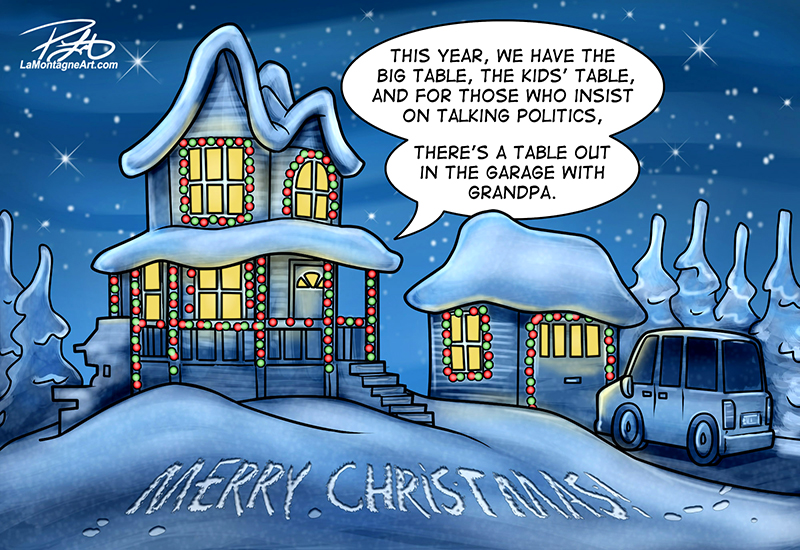 But here’s where it gets weird.
But here’s where it gets weird. True, there’s always a cynical tone to these cartoons, making fun of the season and my issues with it, but that’s a pillar of the editorial cartoonist profession all year long. I usually come up with far too many ideas this time of year, more than I can draw in December.
True, there’s always a cynical tone to these cartoons, making fun of the season and my issues with it, but that’s a pillar of the editorial cartoonist profession all year long. I usually come up with far too many ideas this time of year, more than I can draw in December.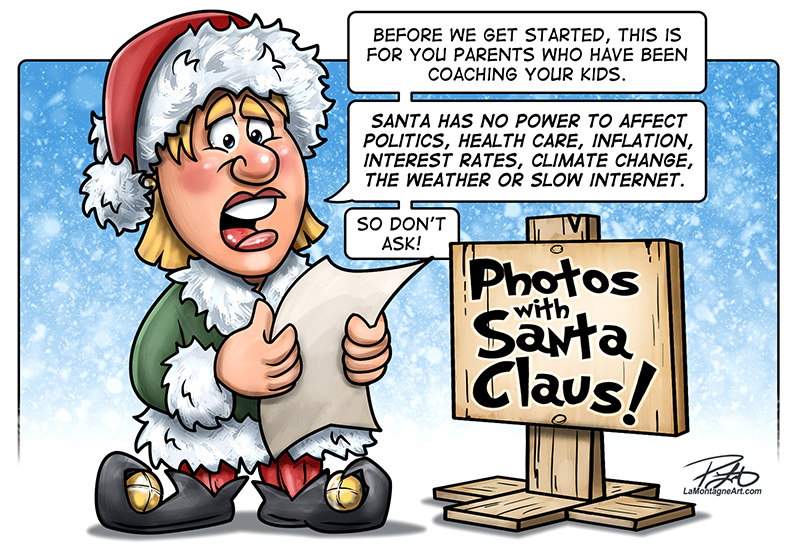
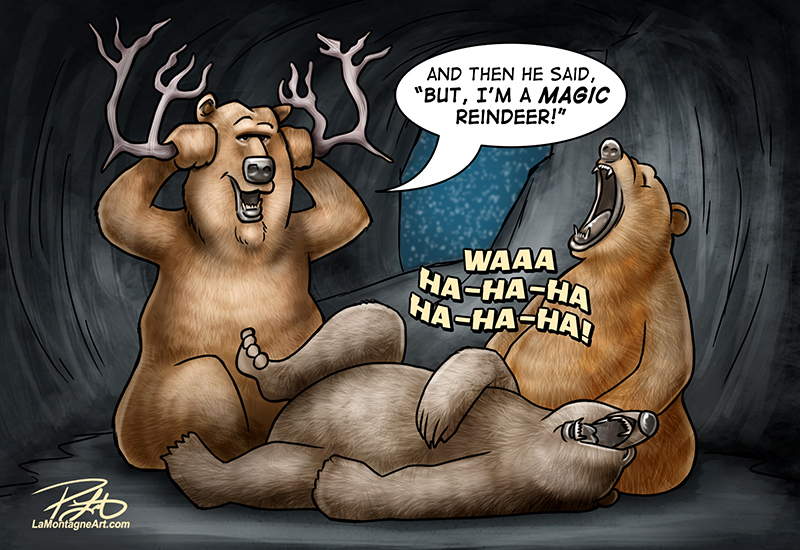
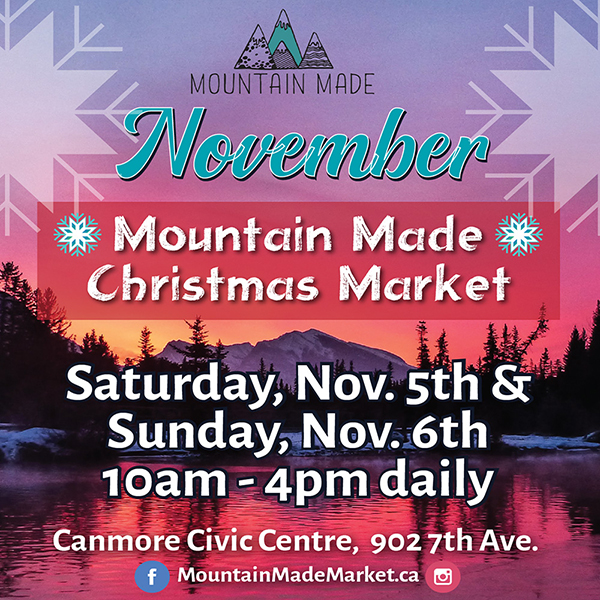
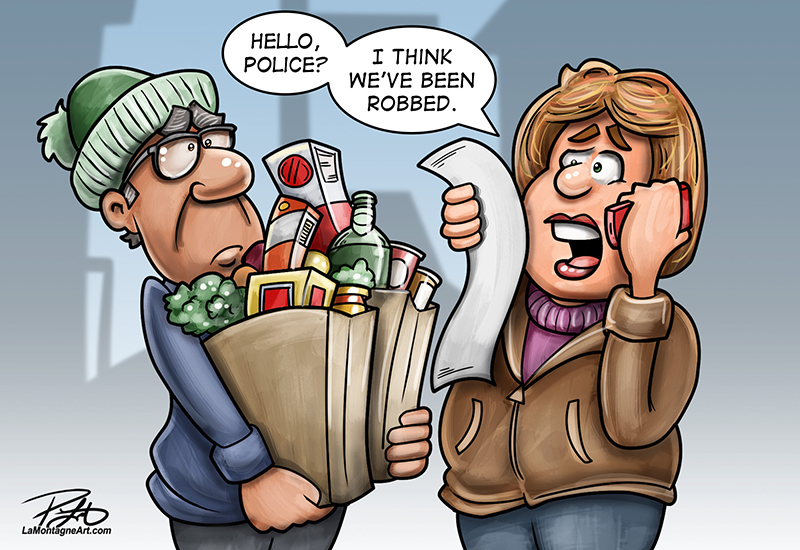 When a telecommunications provider, chain grocery store, or other large corporation that boasts record profits every quarter adds this fee, it is a money grab. These companies have been working hard for years to get people to use credit cards, and it’s included in their pricing.
When a telecommunications provider, chain grocery store, or other large corporation that boasts record profits every quarter adds this fee, it is a money grab. These companies have been working hard for years to get people to use credit cards, and it’s included in their pricing.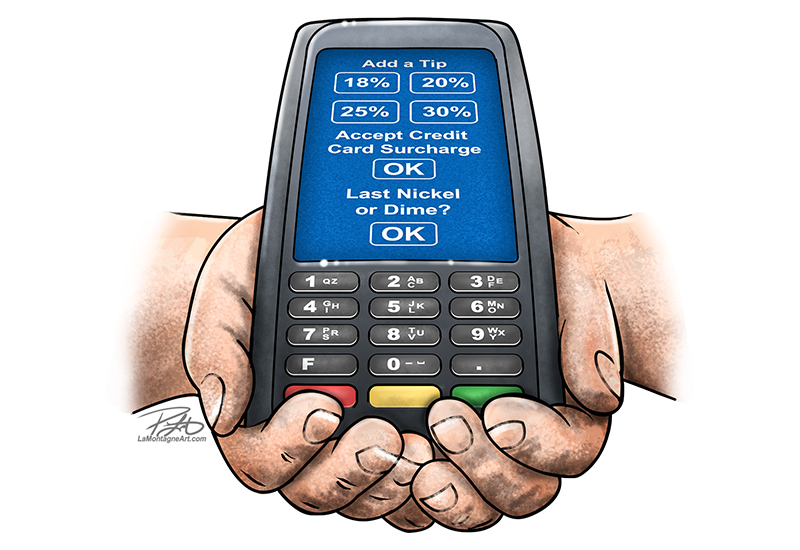 The best we can do is suggest somebody pay by e-transfer as there’s no cost to the consumer or vendor. Debit is also preferred as the transaction fee is significantly less. Or better yet, how about cash, if you even carry that around anymore?
The best we can do is suggest somebody pay by e-transfer as there’s no cost to the consumer or vendor. Debit is also preferred as the transaction fee is significantly less. Or better yet, how about cash, if you even carry that around anymore?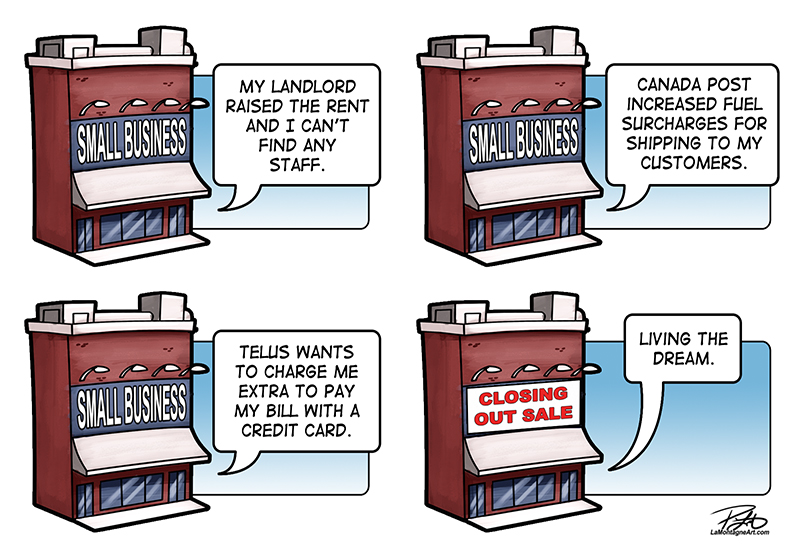 To expect a self-employed small business owner and independent artist to compete with Amazon’s pricing is ludicrous. The only reason they can do that is their sales volume gives them preferred credit card and shipping rates. Any company listing an item on Amazon accepts a much smaller profit margin per item to have a spot on the site.
To expect a self-employed small business owner and independent artist to compete with Amazon’s pricing is ludicrous. The only reason they can do that is their sales volume gives them preferred credit card and shipping rates. Any company listing an item on Amazon accepts a much smaller profit margin per item to have a spot on the site.
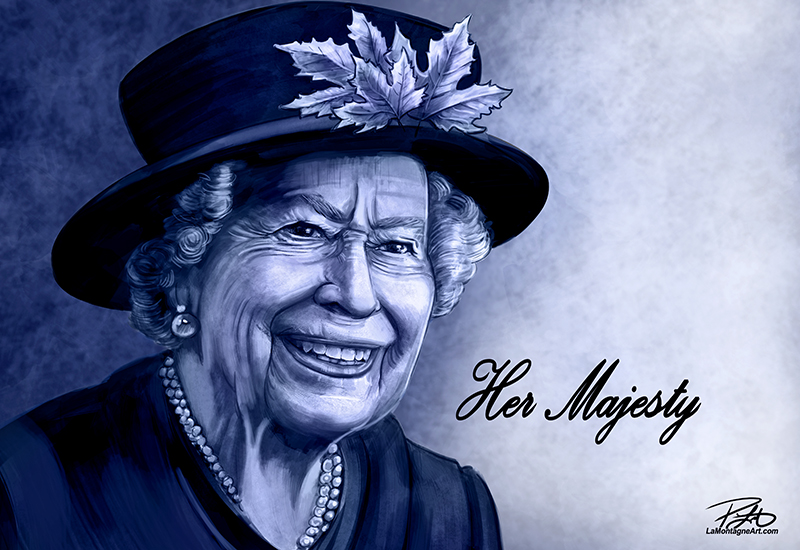 When she got COVID earlier in February, I drew this cartoon, just in case it was time. While it might seem morbid to some, I can assure you that every media outlet in the world has had content and plans laid out far in advance for her inevitable passing. Long before this year, the Queen herself had a hand in the planning of the events of the past two weeks. I felt I’d rather take the time to do the work I wanted, rather than scramble at the last minute just to get it done by deadline.
When she got COVID earlier in February, I drew this cartoon, just in case it was time. While it might seem morbid to some, I can assure you that every media outlet in the world has had content and plans laid out far in advance for her inevitable passing. Long before this year, the Queen herself had a hand in the planning of the events of the past two weeks. I felt I’d rather take the time to do the work I wanted, rather than scramble at the last minute just to get it done by deadline.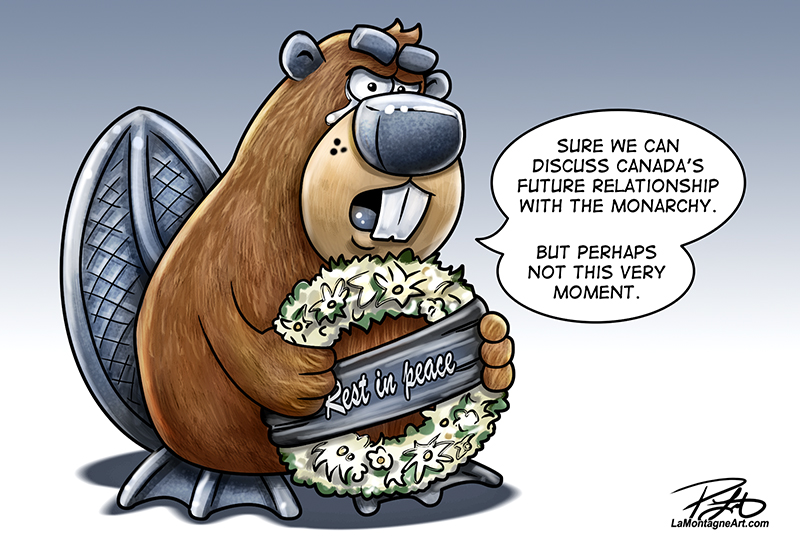 Canadians will no doubt have a necessary conversation in the coming weeks about this country’s relationship with the monarchy and how it will look in the future. But I drew this second cartoon last week reminding readers that it would be crass to dig into that before her interment. I’m not a monarchist, but one need not be to understand simple respect for the recently deceased and empathy for her family and those who grieve her passing.
Canadians will no doubt have a necessary conversation in the coming weeks about this country’s relationship with the monarchy and how it will look in the future. But I drew this second cartoon last week reminding readers that it would be crass to dig into that before her interment. I’m not a monarchist, but one need not be to understand simple respect for the recently deceased and empathy for her family and those who grieve her passing.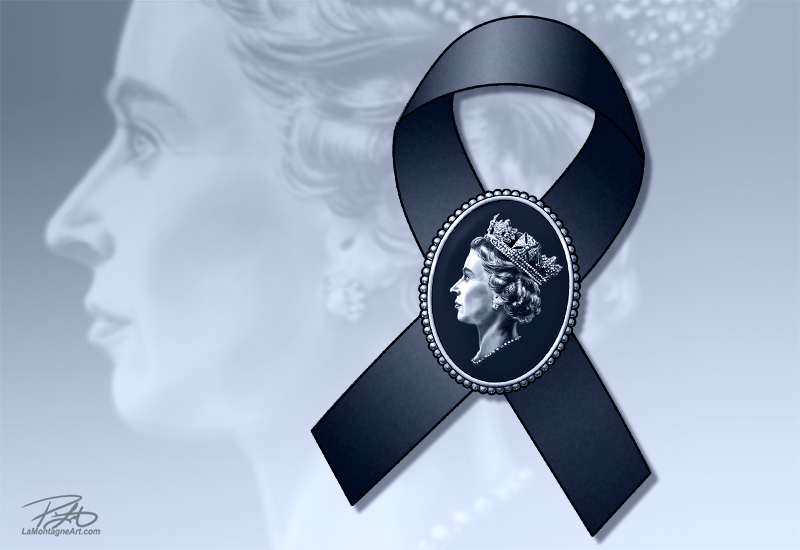 While I don’t enjoy or look forward to drawing them, these types of editorial cartoons are still part of the job.
While I don’t enjoy or look forward to drawing them, these types of editorial cartoons are still part of the job.
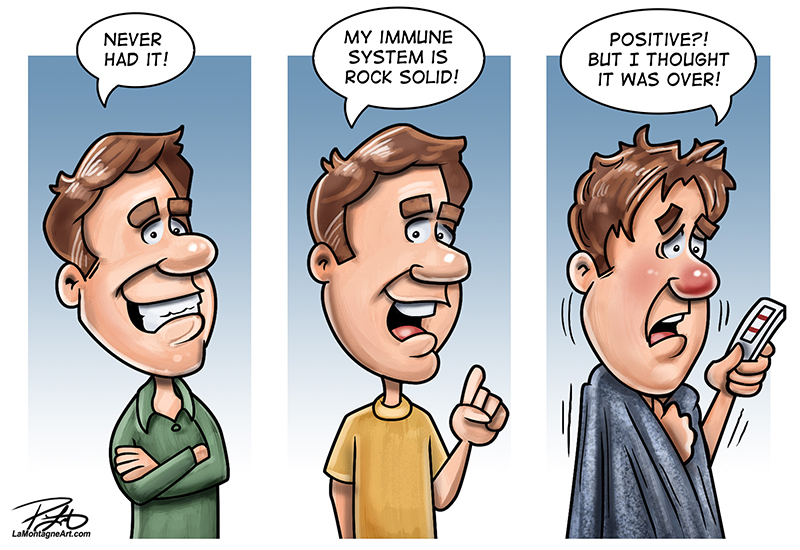 I warned a few people I’d seen days before that I’d tested positive and settled in for what I assumed would be a mild cold. Instead, by Sunday evening, I felt like absolute dogshit.
I warned a few people I’d seen days before that I’d tested positive and settled in for what I assumed would be a mild cold. Instead, by Sunday evening, I felt like absolute dogshit.
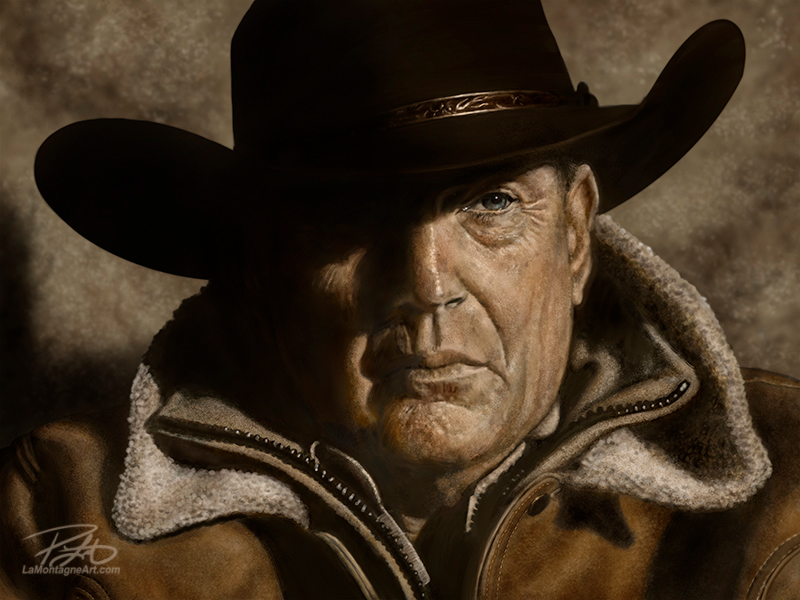
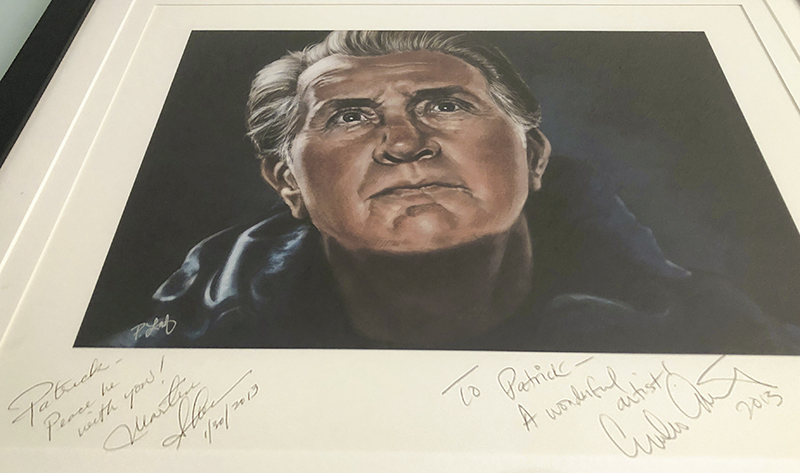 Another was when I painted Canadian astronaut Chris Hadfield while he was in command of the International Space Station. He saw
Another was when I painted Canadian astronaut Chris Hadfield while he was in command of the International Space Station. He saw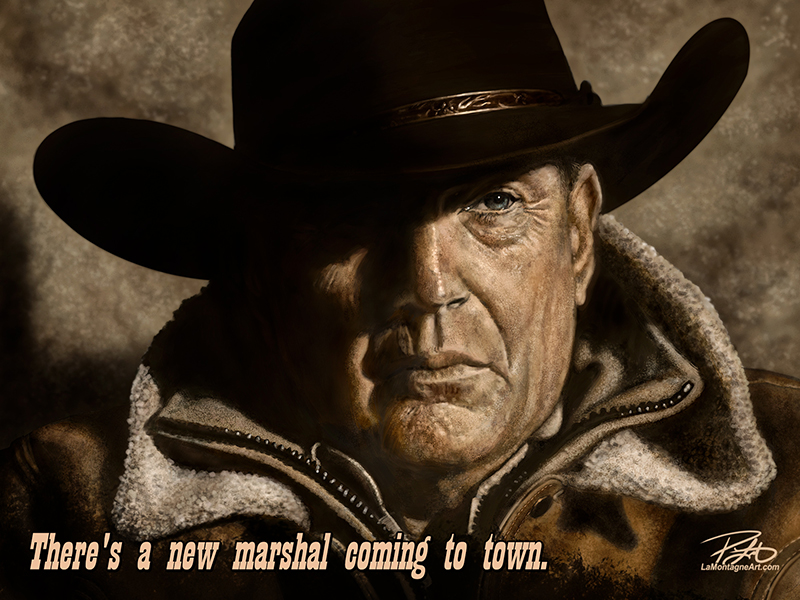 As it also made national news, and Yellowstone is a wildly popular show, I sent it out to my other papers this morning, in case there’s more interest in it. For context outside of Calgary, I added “Calgary Stampede:” before the caption for those other papers.
As it also made national news, and Yellowstone is a wildly popular show, I sent it out to my other papers this morning, in case there’s more interest in it. For context outside of Calgary, I added “Calgary Stampede:” before the caption for those other papers.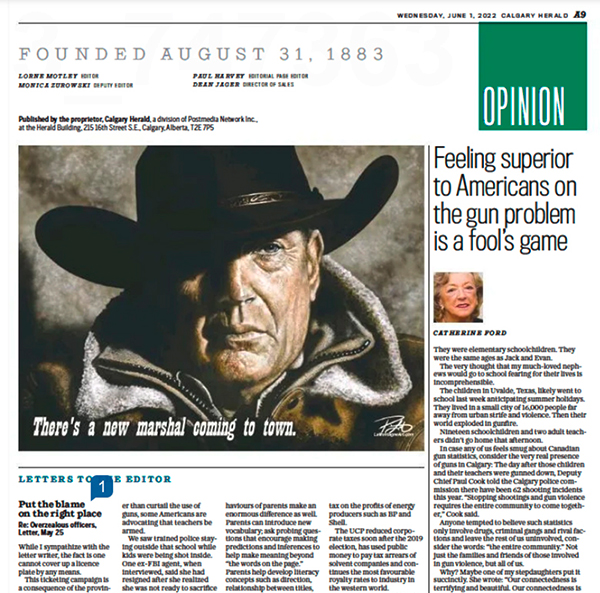 The Costner portrait file is 30” X 40” with a lot of detailed brushwork. To shrink it down and prepare it for newsprint, I had to boost the contrast, oversharpen it, and make other Photoshop adjustments to mitigate a poor result. So while I was happy to see it printed in the Calgary Herald (digital edition above), I couldn’t help but see all the flaws in the reproduction, even though I know that most people won’t notice or care.
The Costner portrait file is 30” X 40” with a lot of detailed brushwork. To shrink it down and prepare it for newsprint, I had to boost the contrast, oversharpen it, and make other Photoshop adjustments to mitigate a poor result. So while I was happy to see it printed in the Calgary Herald (digital edition above), I couldn’t help but see all the flaws in the reproduction, even though I know that most people won’t notice or care.
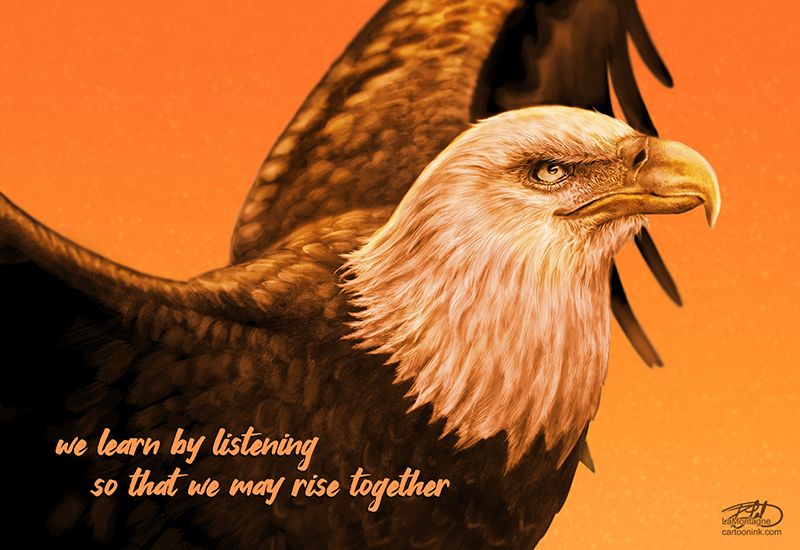 Early in this editorial cartoon profession, somebody once told me that editorial cartoons are supposed to make you laugh, think, and hopefully do both. I think it was Terry Mosher (Aislin).
Early in this editorial cartoon profession, somebody once told me that editorial cartoons are supposed to make you laugh, think, and hopefully do both. I think it was Terry Mosher (Aislin).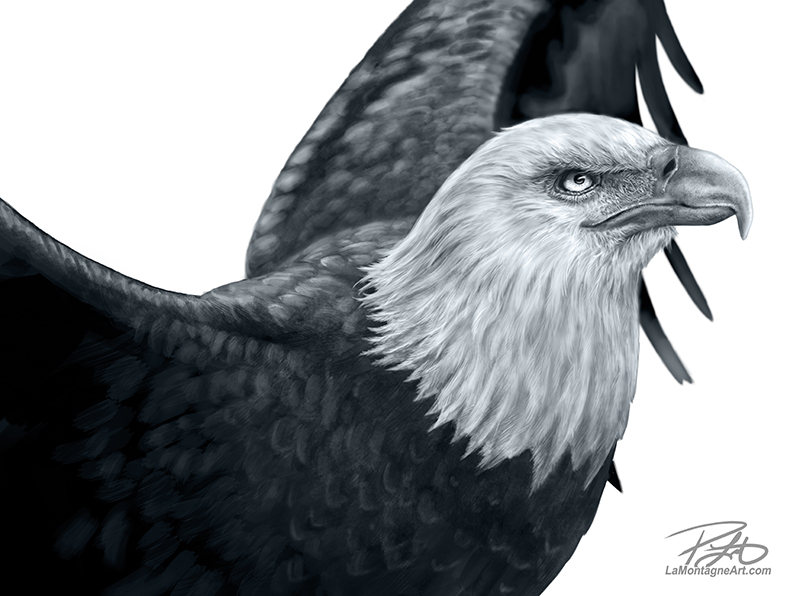 When I first created my animal art, I called them Totems but stopped the practice a few years ago.
When I first created my animal art, I called them Totems but stopped the practice a few years ago.